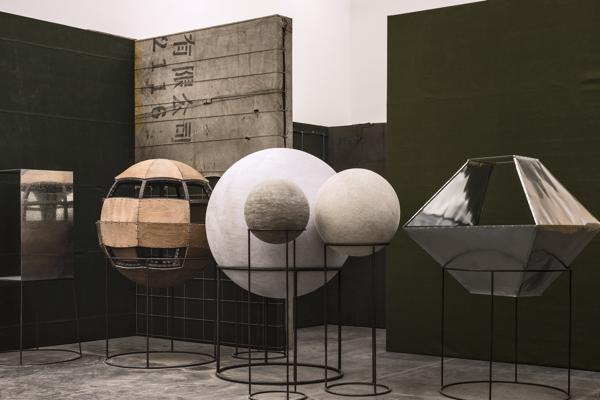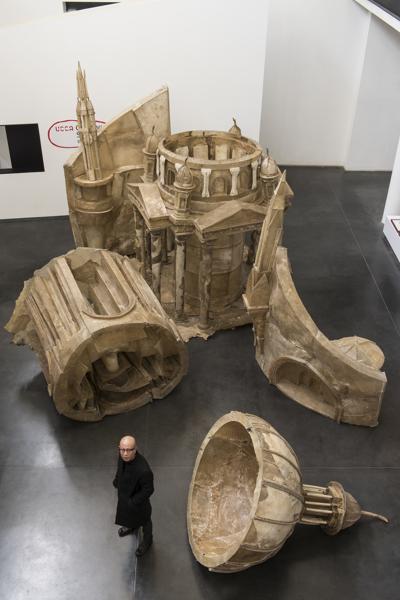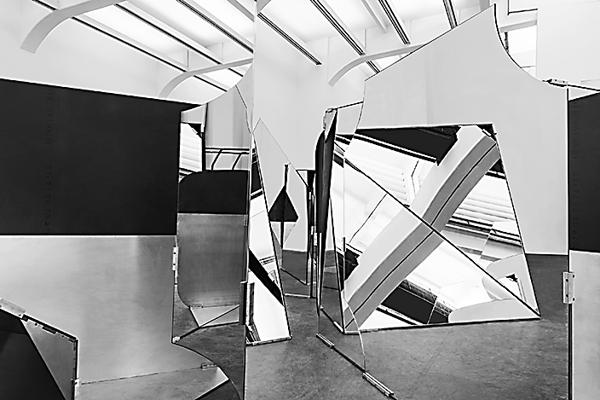
Liu Wei’s solo show Color at Beijing’s Ullens Center for Contemporary Art.[Photo/Provided to China Daily]
Liu Wei tells Lin Qi why he isn’t at home with the notion of being called a conceptual artist.
Although Liu Wei is considered a conceptual artist, he denies the label rather strongly. He says that he isn’t against conceptual art, but because he has made so much “concrete stuff over there (at exhibition venues)”, he cannot be described as a conceptual artist.
He demonstrates his commitment to the concrete rather than the conceptual at his current exhibition at Beijing’s Ullens Center for Contemporary Art, where he juxtaposes his mainly large paintings, videos and installations.
At the “mid-term retrospective”, the Beijing native, 43, has filled UCCA’s entrance and an exhibition hall with the industrial “stuff” he and his team spent weeks putting together: edging iron chips, mirrors, stainless steel structures, wooden blocks of various shapes and giant rectangle boards wrapped in canvas.
There are no definite, obvious borders between these occupying installations and the surroundings, and the spectators. People can just walk into or get very close to them, as if they were visiting the studio of an artist who works with different material.
Actually, the way the works are scattered at the venue does resemble Liu’s studio in Beijing’s Shijiacun Village, except hat, Liu’s assistants point out, there are no discarded cigarette butts on the floor.

Liu Wei stands among his work Love It, Bite It in his solo show Color in Beijing, where the exhibition rooms are filled with large installations.[Photo/Provided to China Daily]
The exhibition is titled Color but that doesn’t mean the exhibition is drenched in colorful hues. With the exception of the paintings, the sculptures and installations feature little coloring and are predominantly in white and gray.
Liu chose the word “color” to examine the way people see the world and to discuss the orders that support society and people’s inner lives.
“Color reflects how we understand the things around us and how we perceive the world,” he says.
He demonstrates his great passion for reading in the artwork Look! Books. He compressed books and printed paper and then shaved and carved them into different shapes resembling marble. He placed these monument-like cubes to make a miniature urban landscape dominated by high-rises.
Liu also displays a new addition to his iconic Love It, Bite It series. He was inspired to create the works after seeing his dog chewing an ox hide toy. In the new work, he seeks to explore the connection between animals’ desire for food and man’s lust for power.
In 2006, Liu created his first Love It, Bite It installations. With the same ox hide material for making chewing toys, he re-created world-famous venues, such as the Pentagon and Tate Modern museum, touching upon the issues of prestige and interest.
In the latest piece now displayed in the UCCA lobby, Liu has employed the forms and elements of religious architecture. The work looks like he has disassembled a religious building into several components and restructured them in a different order.
“I don’t think art is some sort of knowledge. It isn’t produced to lecture people,” he says. “I wish to remove from my works, any traces of existing knowledge and then restore their most elemental status.”

Liu Wei’s solo show Color at Beijing’s Ullens Center for Contemporary Art.[Photo/Provided to China Daily]
Gao Shiming, a professor with the Hangzhou-based China Academy of Art, where Liu studied, says the exhibits speak to Liu’s observations of the community surrounding his studio.
“It is like a divide between the city and the countryside. Local residents do not live an industrial life, or a globalized one. They make almost everything themselves, like an artist does his work. Liu collected their daily waste to produce his works.
“He used the magic of art to piece these objects back together, in a new order he reconstructed.”
Recognized as a success story among the post-1970 generation of Chinese artists, Liu has been commended for his breakthroughs despite the shadows of “cynical realism” and “political pop” from the previous generations on many of his peers.
“Liu and other contemporary artists have found quite a big possibility of expression for Chinese art. They have opened a door. To what, people are not yet quite sure. But it’s only a start,” says Pi Li, senior curator at Hong Kong’s M+ contemporary art museum.
If you go
10 am-7 pm, Tuesday to Sunday, through April 17. UCCA, 798 Art District, 4 Jiuxianqiao Road, Chaoyang district. 010-5780-0200.
